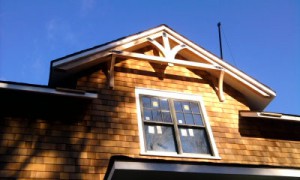Timber Frame Houses Have a Long History
Wooden timbers have been used in the construction of homes for thousands of years. First seen in the Neolithic period, timber home construction has been found by archeologists throughout Europe for many centuries. The earliest timber building found in England dates back to the 12th century, and timber framing has been found all along the coast of the United States dating back to the 1500s.
Lap jointing was the first common method used for timber framed homes. This was followed by a much stronger form of join known as mortise-and-tenon. The constructed frame was durable and considered solid enough to construct multiple stories. The box frame method was next, followed shortly by the cruck/box combination. As home construction became more structurally sound, second and third floors began to have a jetty structure. This was the continuation of the floor space on the upper levels which extended out above the street.
As wood became scarce over the years, building methods changed to include bricks and concrete, but a resurgence of timber framing began again in the 1950s. As the post-war population exploded, the need for homes grew. Wooden homes were quick to construct, and housing areas began to appear with identically constructed homes known by the slang term “cookie cutter homes.” Just as quickly, a problem of quality began to appear as softwood was used in framing and home construction began to have a low-quality feel.
Sweden was a home building exception to the general pattern. Swedish craftsman honed their skills in timber frames because they never changed to bricks or concrete home construction. In fact, the craftsmen created beautiful frames around windows that kept the integrity of the building. This was due to the panel construction method the Swedes developed that allowed for sections of walls to be built and connected instead of whole walls.
Learning from history is what timber framing is all about. Finding old methods of construction and applying them to new approaches can produce highly-efficient and effective building methods. The industry is still changing and growing, and that is a good thing.

